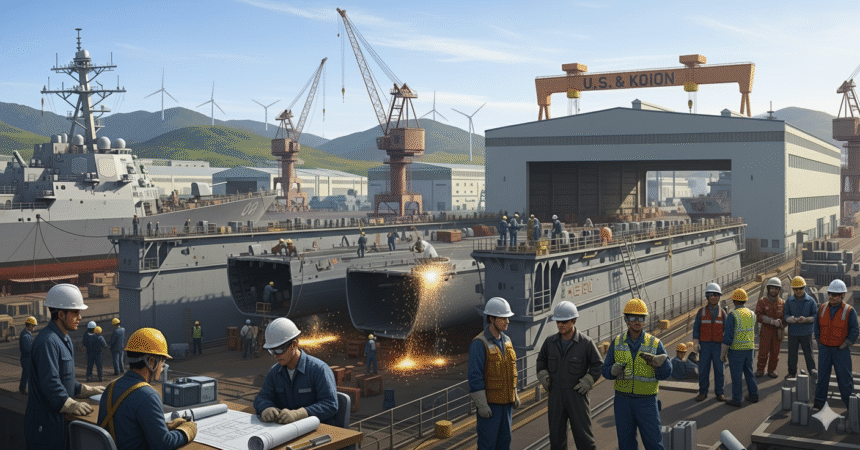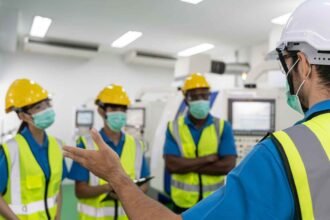In a landmark move, South Korea has pledged a substantial $150 billion investment to strengthen the U.S. shipbuilding sector. This commitment lies at the heart of a broader $350 billion investment initiative, which paved the way for reduced U.S. tariffs on Korean goods, forming a pivotal component of a recent trade accord. These developments unfolded amid an important summit between South Korean President Lee Jae Myung and U.S. President Donald Trump.
The MASGA Vision: Reinvigorating American Shipyards
Dubbed “Make American Shipbuilding Great Again” (MASGA), this campaign aspires to revitalize the U.S. shipbuilding industry through large-scale collaboration. The initiative encompasses a wide array of measures, including investments in U.S. shipyards, workforce development, supply chain modernization, and naval maintenance operations.
At its core, MASGA signals a shared strategy to rebalance naval power, particularly in light of China’s growing maritime influence. South Korea, already a global leader in shipbuilding, offers deep expertise to support U.S. efforts to rebuild its industry.
On the Ground: Hanwha’s $5 Billion Expansion
One of the most tangible steps under MASGA is Hanwha Group’s commitment of $5 billion to expand the Hanwha Philly Shipyard. The project will add two docks and three quays, preparing the yard for advanced production, and potentially boosting annual output from fewer than two vessels to as many as twenty.
The expansion plan also includes a new block assembly facility and investments in automation and high-tech integration. These enhancements aim to support the construction of LNG carriers, naval modules, and eventually warships, all within U.S. soil.
This announcement coincided with President Lee’s visit and a ceremony celebrating the christening of the U.S. Maritime Administration’s third National Security Multi-Mission Vessel. Attending were Governor Josh Shapiro and local officials, who welcomed the prospect of job growth and industrial renewal.
Expanding Efforts: Hyundai and Samsung in the Fold
South Korea’s shipbuilding giants, HD Hyundai Heavy Industries and Samsung Heavy Industries, are also stepping up. HD Hyundai recently finalized a merger with HD Hyundai Mipo to strengthen its capacity to back U.S. maritime demand under MASGA.
HD Hyundai, in concert with Korea Development Bank and Cerberus Capital, is creating an investment fund to support U.S. maritime infrastructure, advanced technologies, and allied capabilities.
Samsung Heavy Industries, meanwhile, has forged an alliance with Vigor Marine Group aimed at modernizing shipyards, engaging in maintenance, and pursuing joint ship construction in U.S. facilities.
Navigating Challenges and Regulatory Barriers
Despite the ambitious plans, there are significant hurdles. For instance, the Jones Act restricts domestic maritime commerce to vessels built within U.S. borders. Meanwhile, the Byrnes–Tollefson Amendment forbids U.S. naval vessel construction overseas, though these restrictions may be relaxed in cases of national security.
U.S. lawmakers have already proposed a “foreign ally shipping registry” to give trusted allies like South Korea greater flexibility in building and maintaining vessels for the U.S.
Administrators caution that U.S. shipbuilding facilities are outdated, the workforce remains small and fragmented, and production capacity is limited. To overcome these issues, experts suggest that Korean firms may need to advise on modernizing infrastructure, plus invest in workforce training, a process that could take years.
Collaboration in Action: Real-World Shipyard Partnerships
South Korea’s assistance is not limited to financial promises. HD Hyundai recently won a maintenance contract from the U.S. Navy for the USNS Alan Shepard, a Lewis and Clark-class vessel. The repairs will occur in Ulsan and mark the first such agreement under MASGA. Other vessel names, like USNS Wally Schirra and USNS Yukon, are also being serviced through cooperation with Hanwha Ocean and Samsung.
These collaborations reflect growing trust and showcase how South Korea is stepping in to shore up U.S. naval readiness, especially in the Indo-Pacific region.
A Turning Point for Strategic Industry Realignment
In sum, South Korea’s $150 billion MASGA pledge, part of a sweeping $350 billion investment plan, marks a pivotal milestone in reshaping U.S.–Korean economic and strategic bonds. Through Hanwha’s shipyard overhaul, HD Hyundai’s funding vehicles, and targeted naval services, this cooperation charts a course for mutual industrial revival.
The venture offers U.S. shipbuilding a rare opportunity to reclaim relevance, while creating pathways for workforce growth, technological modernization, and enhanced defense collaboration. At the same time, legal restrictions and logistical challenges remain, underscoring the complexity of rebuilding a once-proud industry.
As both nations navigate this partnership, its success will hinge on bridging regulatory gaps, ensuring smooth technology transfer, and integrating skilled American workers into modern shipyard operations. If executed well, MASGA could help reignite U.S. maritime capacity and rebalance global shipbuilding dominance for years ahead.









